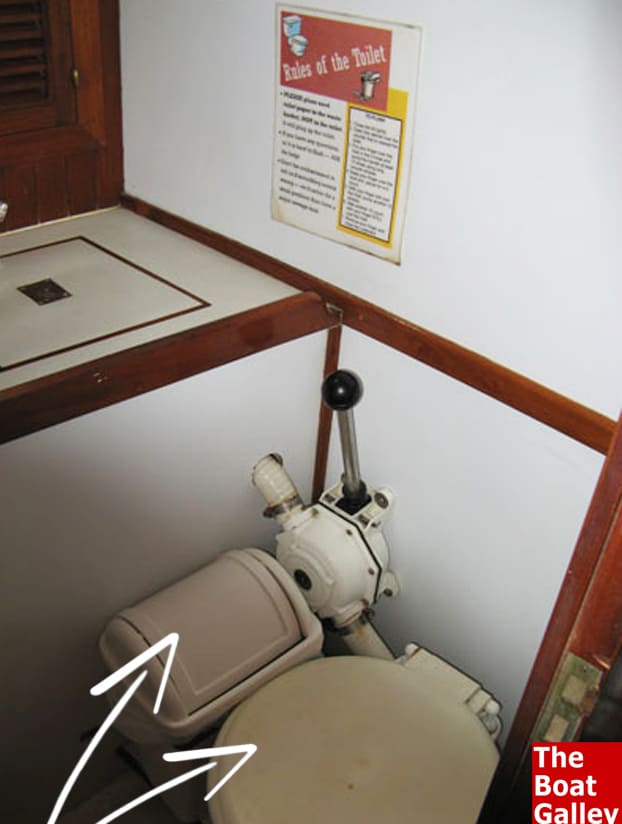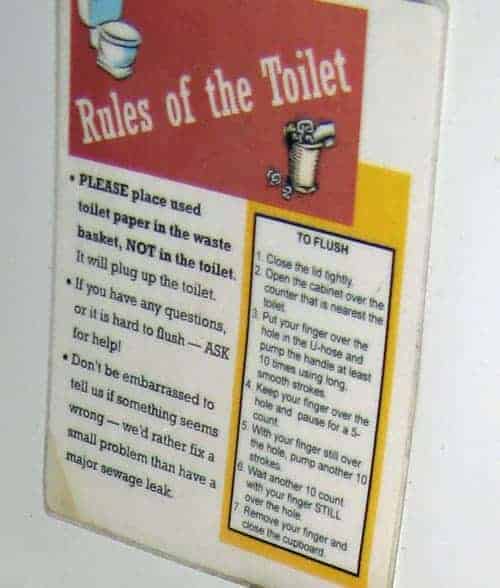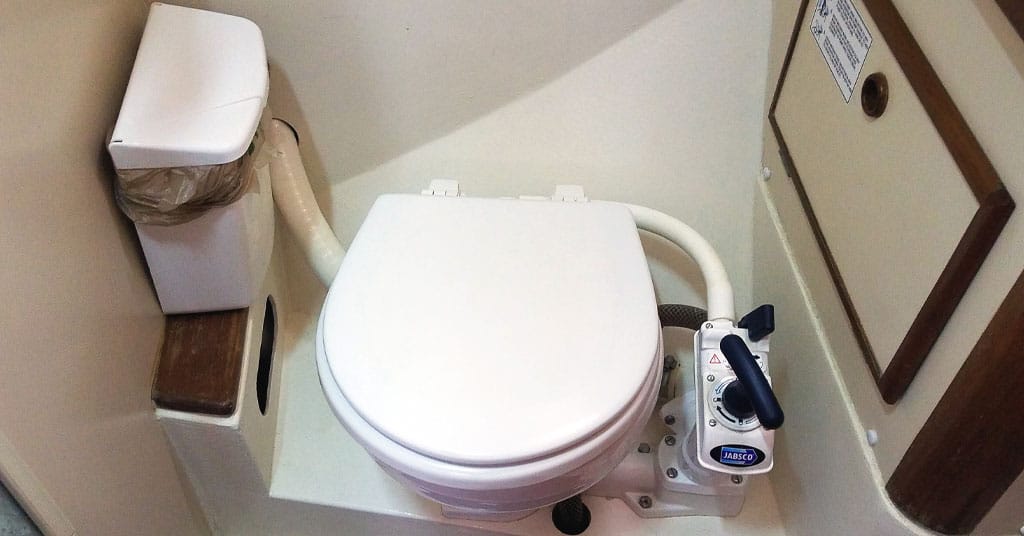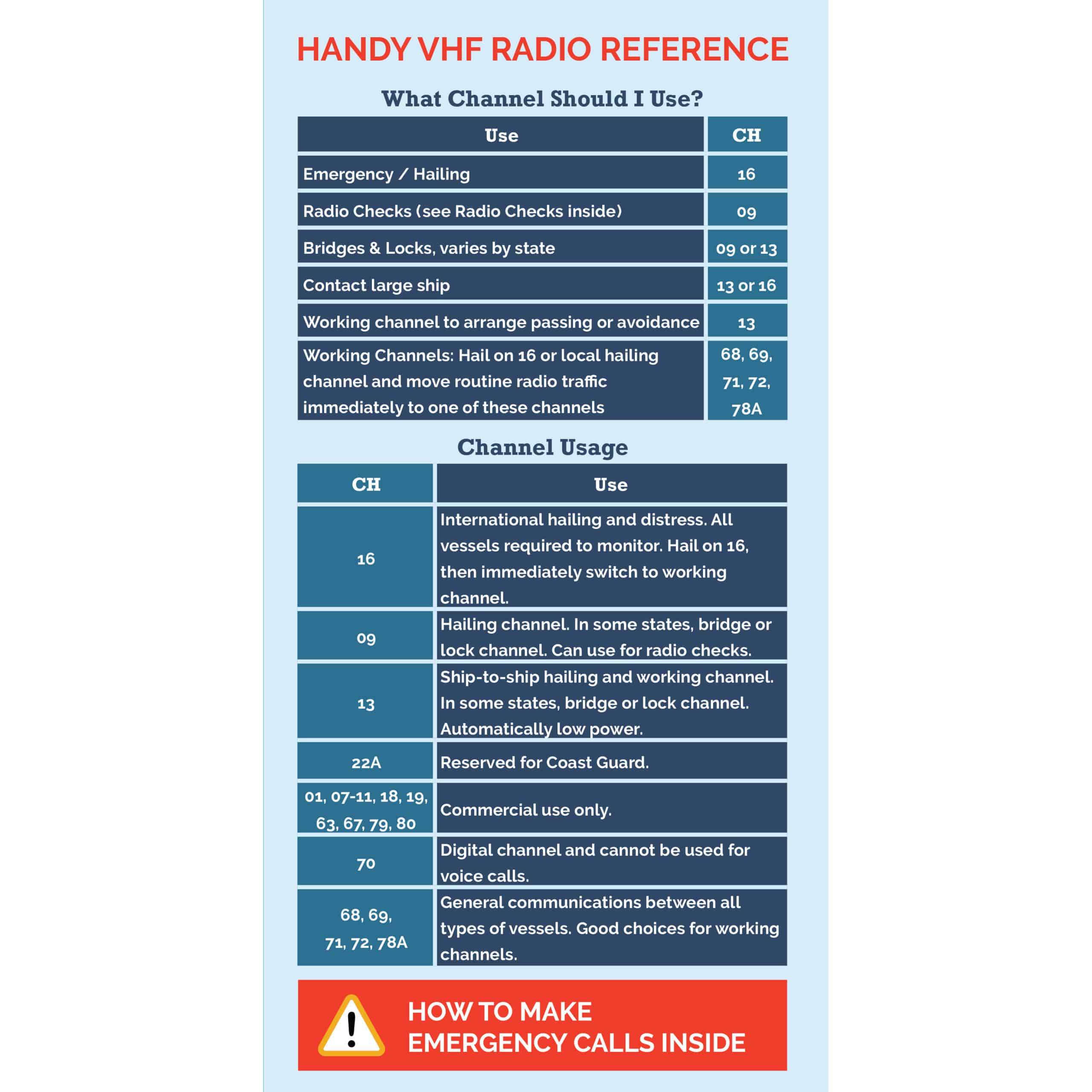Is preventing a clogged head as simple as changing what you do with toilet paper? It can be.
Don’t Flush Toilet Paper
You’ll be a lot less likely to have clogs if you don’t put toilet paper down the head. Instead, do what people in many parts of the world with undersized sewer systems do. Use a lidded wastebasket lined with a plastic bag. Then burn it or otherwise dispose of it daily. A few drops of eucalyptus oil or other air freshener will cover any smell. Tell guests with a polite sign in the head (see below).

Yes, this is a photo of the head in our first boat, Que Tal (we now have a composting toilet on Barefoot Gal). We always put the TP in the trash and so did almost all cruisers in the Sea of Cortez; the joke was that when we’d make a trip to the US or Canada, we’d have a hard time remembering to flush the TP!
Our Thinking on the Subject
I know, a lot of people are going to say “yuck!” And others will say they’ve flushed the TP for years without a clogged head. Dave and I agreed that since Que Tal had only one head, we’d be cautious and not flush paper. After all, neither of us wanted to sweat over an un-flushed toilet in 90+ degree temps. And we hated the idea of using a bucket during the process even more. If you’re willing to risk having to unclog it — in most cruising locales you can’t just call a plumber and let them deal with it — your choice may be different. I’ve also heard of boats that allow flushing but impose a 2-square limit. I find that idea MUCH more repulsive than putting it in a covered container!
Educating Guests
Here’s a close up of our sign. We made two copies of it, one above the pump handle and one where they’d see it while sitting on the toilet. Of course, your flushing instructions will be different but it’s good to post them (ours were particularly strange due to a strange siphon break). Every head is slightly different. And even other cruisers may want instructions on how to use yours. We had the signs laminated so they’d last longer (as you can see, it’s time to re-do them!).

Cruiser Tips
Of course, every cruiser has their favorite tip on the topic (I swear toilet habits cause more arguments than anchor types). Here are a few thoughts from The Boat Galley Readers.
Bruce wrote from the Philippines, where even people on land don’t flush toilet paper. He found it basically odor-free. He continued that toilet paper is a luxury for much of the world. And that a water rinse is a good alternative.
Carlos Nunez agreed with the advice to not use toilet paper. He also recommended a vinegar rinse twice a year to break up calcium deposits that can also contribute to a clogged head.
And Jim stated that he kept a spray bottle next to the toilet and a hanging plastic shopping bag for the toilet paper. He mixed about a 10 to 15% solution of water and vinegar and added 3 or 4 oz of Dawn dishwashing liquid to the bottle. He sprayed the toilet after use and paper in the bag to keep down the odor and aid in disinfection.
The Cruiser Learning Curve
Every aspect of living on a boat is more challenging than living on land. But the rewards are worth it. And you can enjoy those rewards with less stress when you know what to expect. Check out our course, The Basics of Living on a Boat for an introduction to everything anyone new to living on a boat needs to know–including the basics of having a marine head or composting toilet.
Read Next:
Flatten the learning curve with practical how-to info that gives you the confidence to step into life aboard.
Start Learning Today

Carolyn Shearlock has lived aboard full-time for 17 years, splitting her time between a Tayana 37 monohull and a Gemini 105 catamaran. She’s cruised over 14,000 miles, from Pacific Mexico and Central America to Florida and the Bahamas, gaining firsthand experience with the joys and challenges of life on the water.
Through The Boat Galley, Carolyn has helped thousands of people explore, prepare for, and enjoy life afloat. She shares her expertise as an instructor at Cruisers University, in leading boating publications, and through her bestselling book, The Boat Galley Cookbook. She is passionate about helping others embark on their liveaboard journey—making life on the water simpler, safer, and more enjoyable.











Sue says
We have to put the finger over the hole in the siphon break too. We put a blob of bluetac over it when we have guests and discreetly check after they gave been to the head.
Carolyn Shearlock says
🙂
Anonymous says
Does the siphon break create a sinking prevention advantage?
Carolyn Shearlock says
Exactly.
Burt Tandy says
The one thing most dealers of electric toilet and most skippers won’t talk about is how solid solid from a very healthy passenger will sit across the toilet drain or straight as a resisting soldier that no amount of flushing will push down. The other funny and interesting one is the small floating fellow who laughs at you and all your efforts to send him down the drain. In just a few months of use, we’ve had about 8 cases of very embarassing situations, no TP involved in the problem with visitors. Makes you regret the porta potti that you just shake in such a case.
Patrick Marlowe says
Toilet paper is not the problem. It’s the type of toilet paper that causes the problem. Our boat had two of the three toilets clog within days of purchase. We use Scott’s RV Marine toilet paper and not had a clog in 4 years of near full time cruising. This type of paper fully dissolves and does not clog. You should at least talk about this as many people would like an alternative. We actually fly toilet paper back to the Caribbean because marine grade TP is so expensive there.